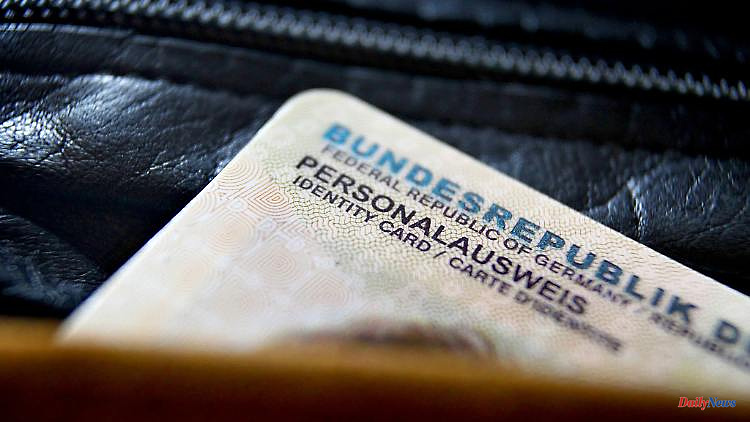Managing health data online or allowing the car to be connected to the Internet: This is made possible by a chip in the ID card that can confirm one's identity online. The E-ID function has so far been little used.
It's a familiar situation: at some point you have to go to the authorities, for example for a certificate, or the car has to be registered or deregistered. That usually means: wait. To an appointment, in a seemingly endless queue, to the next free counter.
In order to avoid such problems, the ID card was beefed up years ago with the E-ID function. Citizens can use this to identify themselves online using a small chip on the card. So you don't have to appear in person for every visit to the authorities or for every contract concluded with insurance companies or companies.
But so far the response has been limited. In the annual e-government survey by the "D21" initiative in 2021, only nine percent of those surveyed stated that they had already used the online ID function. And that despite the fact that three quarters of all Germans have an appropriately equipped identity card in the form of a credit card.
Although new ID cards have only been issued with an activated E-ID function since July 15, 2017, according to a survey, only a quarter of the adult population (26 percent) has an ID with an activated E-ID. Anyone who is not yet a member and would like to have their online ID activated can do so free of charge at the Citizens' Registration Office.
Anyone who has forgotten or lost their personal identification number (PIN) can order a PIN reset letter online. It will be sent to the registered address free of charge and contains an activation code, a QR code and a new PIN.
And what about the online ID function? The ID card portal of the Federal Ministry of the Interior lists around 170 applications: from vehicle registration authorities to the National Weapons Register to BAFöG applications. Telecommunications providers and banks are also involved.
With them you can identify yourself directly when buying a mobile phone prepaid card or when opening an account without having to go to a shop or start a video identification process. And with the Elster portal of the financial administration, an E-ID registration is possible.
And what exactly do you need? A newer smartphone with an NFC chip that can be used to read the chip in the ID if the federal government's "ID app2" is installed. NFC technology is also the basis for contactless payment. So if you already pay with your smartphone, for example, you are well prepared for E-ID.
But you can also reach your goal without a smartphone. But for this you need a suitable card reader that you can connect to your computer, on which the "Ausweisapp2" is then also installed.
There are now also third-party providers for E-ID identification. Whether you have to install their apps or programs depends on the company you want to identify with.
The process of identifying yourself then works like this: hold the ID card under your smartphone or insert it into the card reader and enter your PIN when prompted to do so.
Only those who have their identity card to hand and enter the correct PIN can identify themselves online using an e-ID. In addition, the sensitive data is transmitted end-to-end encrypted directly from the ID chip to the service provider, explains Matthias Gärtner, press spokesman at the Federal Office for Information Security (BSI).
"This requires authorization and a technical authorization certificate," says Gärtner - no certificate, no data access. In addition, the authorization of the provider, such as the licensing authority or the bank, and the data to be transmitted are displayed to the user in advance.
So far, this seems to be working: "The BSI is not aware of any cases of identity theft or unauthorized reading of data that can be traced back to a compromise in the security properties of the chip or the e-ID infrastructure," says Gärtner.
If the ID card has been stolen, lost or you are concerned that the E-ID function has been misused, you can have the online function blocked. This can be done either with the police or at the Citizens’ Registration Office. And there is also a blocking hotline (116 116).
"The blocking password that was communicated in the PIN letter must be kept ready for the call," says Birgitt Paschke from the Federal Office of Administration, which is responsible for the blocks. If the card shows up again or if you want to remove the blocking, you can do this at the responsible Citizens' Registration Office.
After E-ID comes Smart-E-ID. The latter is intended to make online identification even easier by permanently storing the ID card data on the smartphone. The procedure was supposed to start at the end of 2020, but the introduction has been repeatedly postponed. On the one hand, this is due to technical challenges. On the other hand, the Smart-E-ID should also become part of a wallet app, which also includes a driver's license and vaccination card
(This article was first published on Friday, May 27, 2022.)












